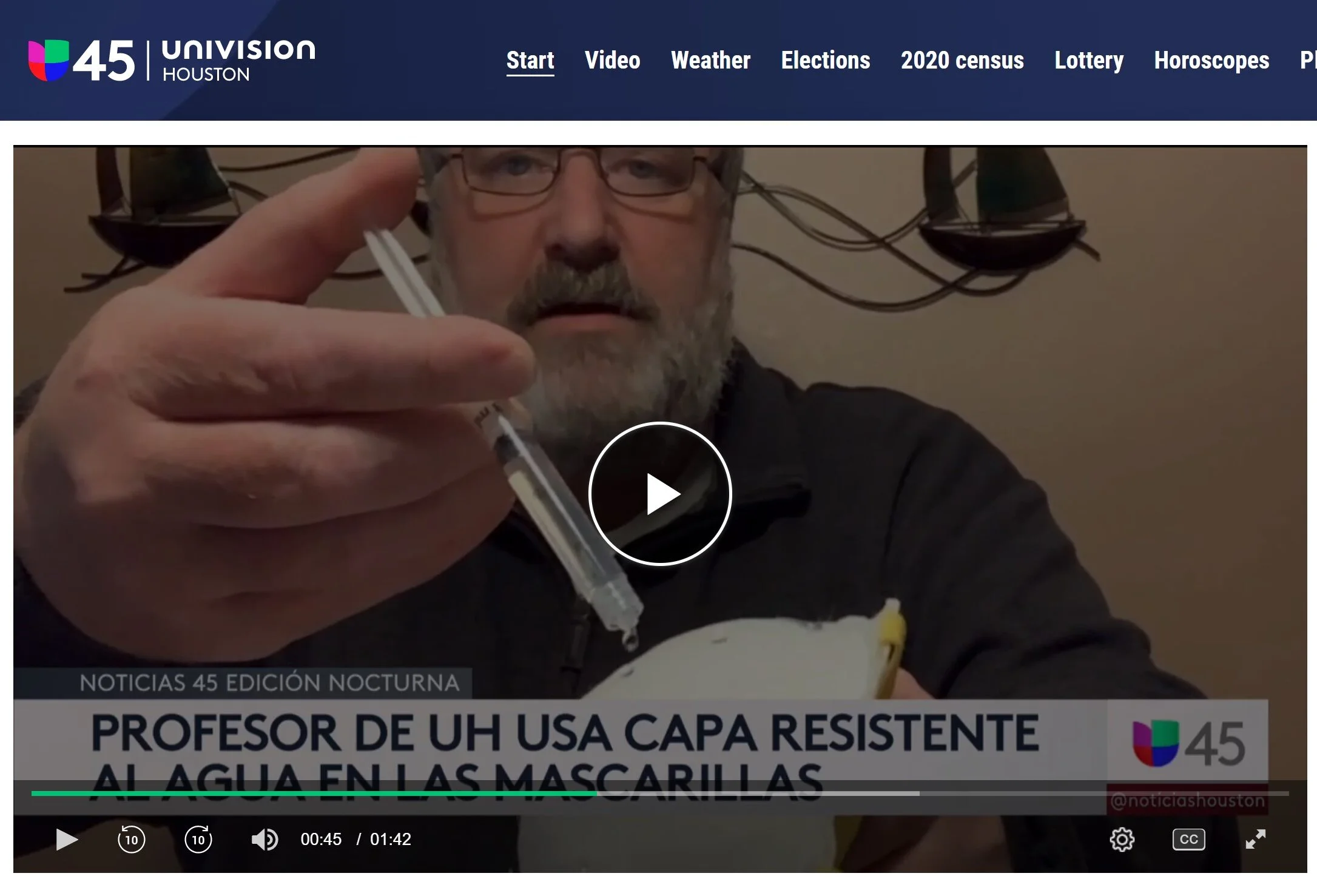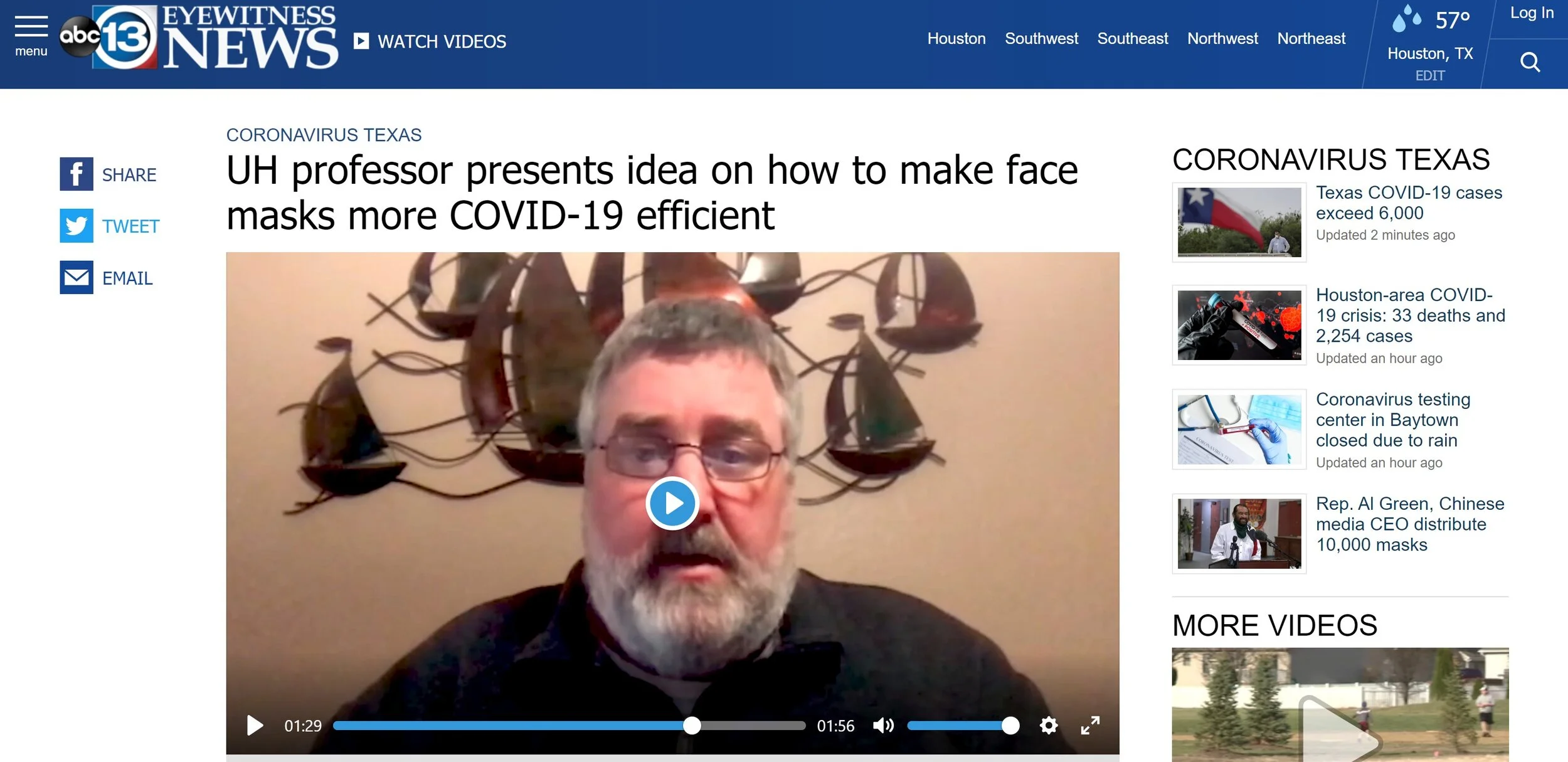Dr. Seamus Curran, a professor of physics at the University of Houston, doesn’t mince words when it comes to society’s need to adjust to the new normal and don masks in public to combat the spread of COVID-19.
“We left normal in December,” Curran tells CultureMap, “and, when everyone was planning their New Year’s resolutions, little did we know that the old normal of before is gone. None of us saw that life passing away — and it was taken away by a bug 1,000 times smaller than lice. And like lice, it’s going to be with us for a long time.”
Nanotech Coating Developed by UH Researchers Improves Protective Abilities of Surgical Masks
We would like to congratulate our CEO, Prof. Shay Curran, and the team for successfully developing a hydrophobic coating that can improve the ability of common masks to protect against the spread of the virus. Common masks are generally porous and can allow virus transmission when they are wet.
A snippet from the original article by-
Jeannie Kever (University of Houston)
HOUSTON, March 31, 2020— Seamus Curran never liked playing defense. Mention a problem, and he wants to take charge.
The coronavirus, it turns out, is no different. Curran, a professor of physics at the University of Houston who is well-known for his work commercializing nanotechnologies, is using a hydrophobic coating he developed almost a decade ago to improve the ability of surgical masks to protect against transmission of the virus.
“Standard masks are somewhat porous, and especially if they get wet, they can allow the virus to penetrate,” Curran said, noting that goes both ways – people infected with the virus could spread it even through a mask, while people who aren’t sick could still become infected, despite wearing a mask.
The link to Integricote’s media release about this work! https://www.integricote.com/news-events-1/2020/3/30/media-release
Coated mask
Uncoated mask
New Material Could Turn Clothing into a Health Monitor
Integricote family would like to congratulate CEO, Prof. Shay Curran, COO (Mr. Alexander J. Wang), Research Scientist (Dr. Surendra Maharjan), and CTO (Dr. Kang-Shyang Liao) for the wonderful work on a composite material that could turn clothing into a Health Monitor. The material is pliable enough to be woven into fabric but imbued with sensing capabilities that could serve as an early warning system for injury or illness. This work was published in ACS Applied Nano Materials.
Congratulations, Team Integricote!
This work was also selected for Supplementary Cover Art by ACS Applied Nano Materials.
A snippet from the original article:
Jeannie Kever
jekever@uh.edu
713-743-0778
The material, described in a paper published by ACS Applied Nano Materials, involves the use of carbon nanotubes and is capable of sensing slight changes in body temperature while maintaining a pliable disordered structure – as opposed to a rigid crystalline structure – making it a good candidate for reusable or disposable wearable human body temperature sensors. Changes in body heat change the electrical resistance, alerting someone monitoring that change to the potential need for intervention.
“Your body can tell you something is wrong before it becomes obvious,” said Seamus Curran, a physics professor at the University of Houston’s College of Natural Sciences & Mathe and co-author on the paper. Possible applications range from detecting dehydration in an ultra-marathoner to the beginnings of a pressure sore in a nursing home patient.
The researchers said it is also cost-effective because the raw materials required are used in relatively low concentrations.
UH Nanotech Startup Enters the ‘Green’ Energy Market
Huge congratulations to our CEO, Prof. Shay Curran, for being featured in the UH Media.
Sealer Protects Clean-Burning Wood Pellets from Water Damage
Jeannie Kever
jekever@uh.edu
713-743-0778
Global energy demand is growing as developing nations expand electric service, prompting efforts to find a readily available source of fuel that is more environmentally friendly than coal.
A nanotechnology company based at the University of Houston’s Technology Bridge research park has a suggestion.
Countries in Europe and Asia already are using wood pellets – a form of biomass made up of compressed sawdust and other wood waste – to fuel power generating stations in an effort to cut fossil fuel emissions.
There are drawbacks, including the fact that the pellets disintegrate easily if exposed to water or even high humidity, raising the cost of storage and transportation. Using solid wood pellets can help, but that raises the cost substantially.
Seamus “Shay” Curran, a physicist at UH and CEO of Integricote, said researchers have discovered that a nanotech coating can protect the composite pellets from degradation without affecting how they burn or the amount of energy they can produce.
The company launched in late 2013, marketing a water- and stain-repellant coating developed by Curran. It later changed its name to Integricote and now offers products to seal and stain wood, masonry and concrete. They work by penetrating the surface of the material and forming a protective barrier below.
The pellets don’t burn as hot as coal, so more pellets must be burned to produce an equivalent amount of energy. But Curran said the pellets are a green energy solution because they produce fewer emissions than either coal or larger chunks of wood and can be produced from wood waste.
“It makes sense to use this,” he said. “We have issues with coal, so could we change our coal-fired plants to use something else?”
Wood pellets are produced in the United States and Canada, making them a domestic energy solution, Curran said.
Integricote markets its sealers and stains under the name CaraPro and produces them in facilities at the UH Technology Bridge (formerly known as the Energy Research Park) on the Gulf Freeway.
They are available on the East Coast through a distributor and are also sold through the website.
The coating for pellets would be the company’s first industrial product; Curran said Integricote is currently looking for a partner to produce the treated pellets.
“I got into this thinking I could solve a problem,” he said. “We don’t have to shut down every coal plant to be thinking green.”
- Jeannie Kever, University Media Relations
Integricote CEO, Dr. Shay Curran on KHUF 88.7 Radio Interview
Integricote featured in the University of Houston News
Integricote develops superhydrophobic/oleophilic absorbent material for crude oil cleanup
Integricote is proud to announce the launch of a new product that selectively absorbs hydrocarbons/oil from aqueous hydrocarbon/oil mixtures or emulsions. Rooted in nanotechnology developed three years ago, Integricote’s new oleophilic/hydrophobic materials are now ready for market after extensive trials and testing. This technology is immensely adept at recovering hydrocarbons/oils following environmentally/ecologically disastrous events (e.g., oil spills/leaks) – effectively reducing the risk of marine pollution while minimizing monetary losses by recovering lost hydrocarbons/oils.
Please enjoy the video: || Oil/Water Separation using Superhydrophobic/Oleophilic Cloth ||













